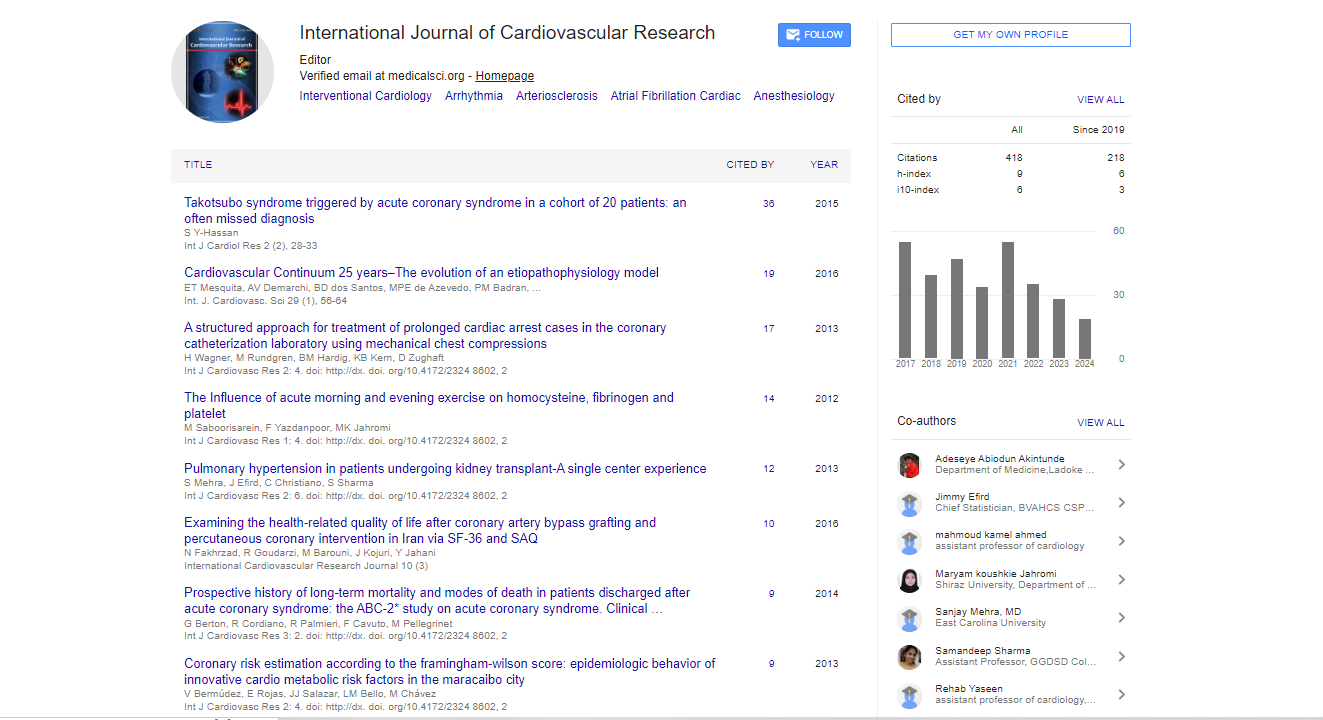Commentary, Int J Cardiol Res Vol: 13 Issue: 6
Neuroprotective Drugs for Post-Cardiac Arrest Syndrome
Thabo Dlamini*
1Department of Cardiology, University of Cape Town, Cape Town, South Africa
*Corresponding Author: Thabo Dlamini,
Department of Cardiology, University of
Cape Town, Cape Town, South Africa
E-mail: thabo.dlamini@uct.ac.za
Received date: 28 November, 2024 Manuscript No. ICRJ-24-156846;
Editor assigned date: 02 December, 2024, PreQC No. ICRJ-24-156846 (PQ);
Reviewed date: 16 December, 2024, QC No. ICRJ-24-156846;
Revised date: 23 December, 2024, Manuscript No. ICRJ-24-156846 (R);
Published date: 30 December, 2024, DOI: 10.4172/2324-8602.1000593.
Citation: Dlamini T (2024) Neuroprotective Drugs for Post- Cardiac Arrest Syndrome. Int J Cardiol Res 13:6.
Description
Post-Cardiac Arrest Syndrome (PCAS) is a complex and multifactorial condition that occurs after the Return of Spontaneous Circulation (ROSC) in patients who have suffered from a cardiac arrest. It is characterized by a combination of neurological and systemic manifestations that require immediate and sustained medical intervention. The neurological impairments that arise following a cardiac arrest are a significant cause of morbidity and mortality, leading to long-term disabilities and a substantial burden on healthcare systems. Among the key components of management in PCAS, neuroprotection plays an important role in improving patient outcomes, particularly by reducing brain injury caused by ischemia and reperfusion. Cardiac arrest induces a state of cerebral hypoxia and ischemia, both of which can lead to significant brain injury. When circulation is restored, oxygen and nutrients are abruptly reintroduced to brain tissues, leading to a phenomenon known as reperfusion injury. This paradoxical process, while necessary for tissue recovery, often causes further neuronal damage through the generation of Reactive Oxygen Species (ROS), inflammation and excitotoxicity. Therefore, timely and effective neuroprotective strategies are paramount to minimizing the extent of neuronal injury and improving survival rates.
The brain is highly vulnerable to ischemia due to its high metabolic demand, low capacity for anaerobic metabolism and limited ability to store energy reserves. During cardiac arrest, the cessation of blood flow leads to a rapid depletion of oxygen and glucose, essential for neuronal function. Upon the restoration of circulation, reperfusion intensifies the damage. The rapid reoxygenation of tissues triggers the production of free radicals, including ROS, which can damage cell membranes, proteins and DNA. This process is coupled with the activation of inflammatory pathways and a series of excitotoxic events involving glutamate, the brain's primary excitatory neurotransmitter. Excitotoxicity occurs when glutamate accumulates in the synaptic cleft, binding to N-Methyl-D-Aspartate (NMDA) receptors on neurons and resulting in calcium influx. This ion overload leads to mitochondrial dysfunction, further ROS production and neuronal apoptosis. Inflammatory mediators, such as cytokines and prostaglandins, are also released in response to ischemiareperfusion injury, creating a neuroinflammatory environment that worsens neuronal damage.
Given the role of excitotoxicity in neuronal injury following cardiac arrest, NMDA receptor antagonists have emerged as potential neuroprotective agents. Memantine, an NMDA receptor antagonist, has been investigated for its ability to attenuate excitotoxic damage. Preclinical studies suggest that memantine can reduce neuronal injury and improve neurological outcomes in animal models of cardiac arrest. However, clinical trials have shown inconsistent results, with some studies reporting no significant benefit. One of the challenges with NMDA receptor antagonists is that they must strike a balance between protecting neurons from excitotoxicity and avoiding interference with normal synaptic transmission. Calcium overload is a hallmark of ischemia-reperfusion injury, as excessive calcium influx into neurons disrupts mitochondrial function and triggers apoptotic pathways. Nimodipine, a calcium channel blocker, has been examined as a potential neuroprotective drug due to its ability to limit calcium entry and reduce neuronal damage. In animal models of PCAS, nimodipine has demonstrated a reduction in brain injury and improved survival. Clinical trials are ongoing to determine its effectiveness in human patients, with some promising results suggesting improved outcomes when combined with therapeutic hypothermia, another common neuroprotective approach.
Despite significant advancements in understanding the pathophysiology of PCAS, effective neuroprotective drugs remain elusive. One of the primary challenges lies in the complexity and heterogeneity of the condition itself. The varied responses to ischemia, the timing of resuscitation and the individual patient's clinical profile all contribute to the difficulty of developing universal therapeutic strategies. Additionally, the blood-brain barrier presents a substantial obstacle to the delivery of many promising neuroprotective drugs. Future study and efforts should focus on identifying biomarkers that can predict the severity of brain injury and guide individualized therapeutic interventions. Additionally, the development of combination therapies that target multiple aspects of the pathophysiology of PCAS, including oxidative stress, excitotoxicity and inflammation, holds promise for improving patient outcomes. The integration of neuroprotective drugs with advanced techniques like therapeutic hypothermia and Extracorporeal Membrane Oxygenation (ECMO) may also enhance the efficacy of treatment.
Conclusion
Neuroprotection in the context of post-cardiac arrest syndrome is an important component of improving survival and neurological outcomes. While several pharmacological agents have shown promise in preclinical studies, their translation into clinical practice has been slow. The complexity of the syndrome, combined with the challenges of drug delivery and patient variability, makes the development of effective neuroprotective therapies a formidable task. However, ongoing study and clinical trials offer hope that a more effective therapeutic approach will emerge, ultimately improving the prognosis for patients who survive cardiac arrest.
 Spanish
Spanish  Chinese
Chinese  Russian
Russian  German
German  French
French  Japanese
Japanese  Portuguese
Portuguese  Hindi
Hindi 



